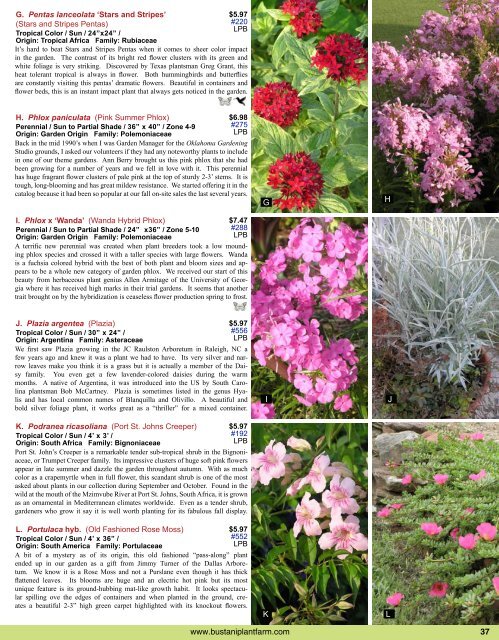Download Catalog - Bustani Plant Farm
Download Catalog - Bustani Plant Farm
Download Catalog - Bustani Plant Farm
Create successful ePaper yourself
Turn your PDF publications into a flip-book with our unique Google optimized e-Paper software.
G. Pentas lanceolata ‘Stars and Stripes’<br />
(Stars and Stripes Pentas)<br />
Tropical Color / Sun / 24”x24” /<br />
Origin: Tropical Africa Family: Rubiaceae<br />
It’s hard to beat Stars and Stripes Pentas when it comes to sheer color impact<br />
in the garden. The contrast of its bright red flower clusters with its green and<br />
white foliage is very striking. Discovered by Texas plantsman Greg Grant, this<br />
heat tolerant tropical is always in flower. Both hummingbirds and butterflies<br />
are constantly visiting this pentas’ dramatic flowers. Beautiful in containers and<br />
flower beds, this is an instant impact plant that always gets noticed in the garden.<br />
H. Phlox paniculata (Pink Summer Phlox)<br />
Perennial / Sun to Partial Shade / 36” x 40” / Zone 4-9<br />
Origin: Garden Origin Family: Polemoniaceae<br />
$5.97<br />
#220<br />
LPB<br />
Back in the mid 1990’s when I was Garden Manager for the Oklahoma Gardening<br />
Studio grounds, I asked our volunteers if they had any noteworthy plants to include<br />
in one of our theme gardens. Ann Berry brought us this pink phlox that she had<br />
been growing for a number of years and we fell in love with it. This perennial<br />
has huge fragrant flower clusters of pale pink at the top of sturdy 2-3’ stems. It is<br />
tough, long-blooming and has great mildew resistance. We started offering it in the<br />
catalog because it had been so popular at our fall on-site sales the last several years.<br />
I. Phlox x ‘Wanda’ (Wanda Hybrid Phlox)<br />
Perennial / Sun to Partial Shade / 24” x36” / Zone 5-10<br />
Origin: Garden Origin Family: Polemoniaceae<br />
$6.98<br />
#275<br />
LPB<br />
A terrific new perennial was created when plant breeders took a low mounding<br />
phlox species and crossed it with a taller species with large flowers. Wanda<br />
is a fuchsia colored hybrid with the best of both plant and bloom sizes and appears<br />
to be a whole new category of garden phlox. We received our start of this<br />
beauty from herbaceous plant genius Allen Armitage of the University of Georgia<br />
where it has received high marks in their trial gardens. It seems that another<br />
trait brought on by the hybridization is ceaseless flower production spring to frost.<br />
J. Plazia argentea (Plazia)<br />
Tropical Color / Sun / 30” x 24” /<br />
Origin: Argentina Family: Asteraceae<br />
$7.47<br />
#288<br />
LPB<br />
We first saw Plazia growing in the JC Raulston Arboretum in Raleigh, NC a<br />
few years ago and knew it was a plant we had to have. Its very silver and narrow<br />
leaves make you think it is a grass but it is actually a member of the Daisy<br />
family. You even get a few lavender-colored daisies during the warm<br />
months. A native of Argentina, it was introduced into the US by South Carolina<br />
plantsman Bob McCartney. Plazia is sometimes listed in the genus Hyalis<br />
and has local common names of Blanquilla and Olivillo. A beautiful and<br />
bold silver foliage plant, it works great as a “thriller” for a mixed container.<br />
K. Podranea ricasoliana (Port St. Johns Creeper)<br />
Tropical Color / Sun / 4’ x 3’ /<br />
Origin: South Africa Family: Bignoniaceae<br />
$5.97<br />
#556<br />
LPB<br />
Port St. John’s Creeper is a remarkable tender sub-tropical shrub in the Bignoniaceae,<br />
or Trumpet Creeper family. Its impressive clusters of huge soft pink flowers<br />
appear in late summer and dazzle the garden throughout autumn. With as much<br />
color as a crapemyrtle when in full flower, this scandant shrub is one of the most<br />
asked about plants in our collection during September and October. Found in the<br />
wild at the mouth of the Mzimvube River at Port St. Johns, South Africa, it is grown<br />
as an ornamental in Mediterranean climates worldwide. Even as a tender shrub,<br />
gardeners who grow it say it is well worth planting for its fabulous fall display.<br />
L. Portulaca hyb. (Old Fashioned Rose Moss)<br />
Tropical Color / Sun / 4’ x 36” /<br />
Origin: South America Family: Portulaceae<br />
$5.97<br />
#192<br />
LPB<br />
$5.97<br />
#552<br />
LPB<br />
A bit of a mystery as of its origin, this old fashioned “pass-along” plant<br />
ended up in our garden as a gift from Jimmy Turner of the Dallas Arboretum.<br />
We know it is a Rose Moss and not a Purslane even though it has thick<br />
flattened leaves. Its blooms are huge and an electric hot pink but its most<br />
unique feature is its ground-hubbing mat-like growth habit. It looks spectacular<br />
spilling ove the edges of containers and when planted in the ground, creates<br />
a beautiful 2-3” high green carpet highlighted with its knockout flowers.<br />
G<br />
I<br />
K<br />
www.bustaniplantfarm.com 37<br />
H<br />
J<br />
L


